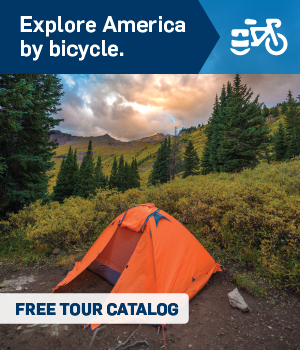Equipment and Elevation
Bike Selection
Ride what you got. Just about every type of bicycle has been used on our tours. We’ve seen touring bikes, racing bikes, recumbents, mountain bikes, tandems, trikes, and even triples. For safety and comfort, we strongly recommend higher-volume tires for paved-road trips — at least 700c x 28-32mm and 2.0 in. tires on our mountain bike tours. On gravel tours, riders will find the most comfort with 42mm or larger tires. Considering an eBike? Only pedal assist (Class 1) eBikes are allowed and only on select fully supported and inn-to-inn tours.
We encourage you to ride the bike you’re comfortable with and to come prepared with the extra tubes and tools you’ll need to repair a flat tire. For our off-road and mixed surface tours, we strongly suggest a mountain, hybrid, or gravel bike with tires with a slightly more aggressive tread. On off-road trips that include technical terrain, a mountain bike equipped to handle rough single-track is necessary.
Many of our tours have bike rentals available through local bike shops. With your 60 day Tour Information Packet, we'll send you more information about the shop and if rentals are available.
If you have questions about the suitability of your bike for a specific trip, please call us at 800.611.8687 or email us at tours@adventurecycling.org.
Equipment
You'll need a variety of equipment for your tour in addition to your bike. From camping gear to cycling clothes, and panniers or a trailer to carry your stuff on our self contained and inn-to-inn tours. We have recommended packing lists in our Before You Go booklets, which can be found on our FAQs page under Level of Service. We also have great knowledge and products available at our Cyclosource store.
As you select the equipment for your tour, consider talking to your local bike shop and outdoor outfitter, tell them about the trip you are going on, and they'll be able to make some recommendations on the best gear.
Trip Elevation
Some of our rides take place at high elevations and others have significant cumulative elevation gains. If you are planning a cycling trip at higher elevations (most people can go to 7,000 feet with little or no negative effect), the best way to prepare is to arrive at the starting point a few days early to acclimatize. The effects of high altitude cannot be predicted by factors such as age or physical condition. However, some key considerations include:
Less Oxygen
At high elevations, it can feel like you are trying to breathe through a straw, speeding up your breathing. The easiest place to breathe is at sea level, which has the most oxygen. Oxygen decreases 3–4% for every 1,000 feet above sea level.
Less Humidity
In addition to a decrease in oxygen, humidity decreases as elevation increases. This has the effect of drawing moisture from your body and, combined with faster breathing due to less oxygen, causes your body to lose moisture more rapidly. To offset low humidity and moisture loss, it is important to consume more liquids than you normally do throughout the day.
Less Protection from Sun
Ultraviolet radiation increases 4–5% for every 1,000 feet above sea level, so sunburn occurs more easily. To help offset the increase in UV rays, use sunscreen with a high SPF (Sun Protection Factor) and/or protective clothing, as well as sunglasses to protect your eyes.
To ease the transition process to high elevations: eat lightly, drink plenty of fluids, avoid alcohol for the first 48 hours, and get plenty of rest.
To identify trips with high-altitude riding or significant cumulative climbing, please view the “Tour Details” box for elevation alert notations. The Adventure Cycling tours department welcomes your calls if you have questions or concerns regarding trip climbing or elevation. Contact us at 800.611.8687 or tours@adventurecycling.org.
Tour Team Top Picks
- Big Bend
-

-
Van Supported. This ten-day trip explores the wild and picturesque terrain of the West Texas Big Bend region. Explore this road-riding dreamland, and let the van haul the gear!
- Natchez Trace
-

-
Van Supported.The Natchez Trace Parkway is one of the North American continent's crown-jewel byways. We're going to pedal every inch of this nearly continuous greenway linking the southern Appalachian foothills and the bluffs of the lower Mississippi River.
- Florida Keys
-

-
Van Supported. Get a second dose of summer with this Sunshine State ride. You can smile wide as you ride knowing you're enjoying 300 miles of sunny, warm weather!
